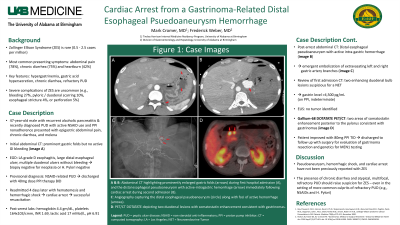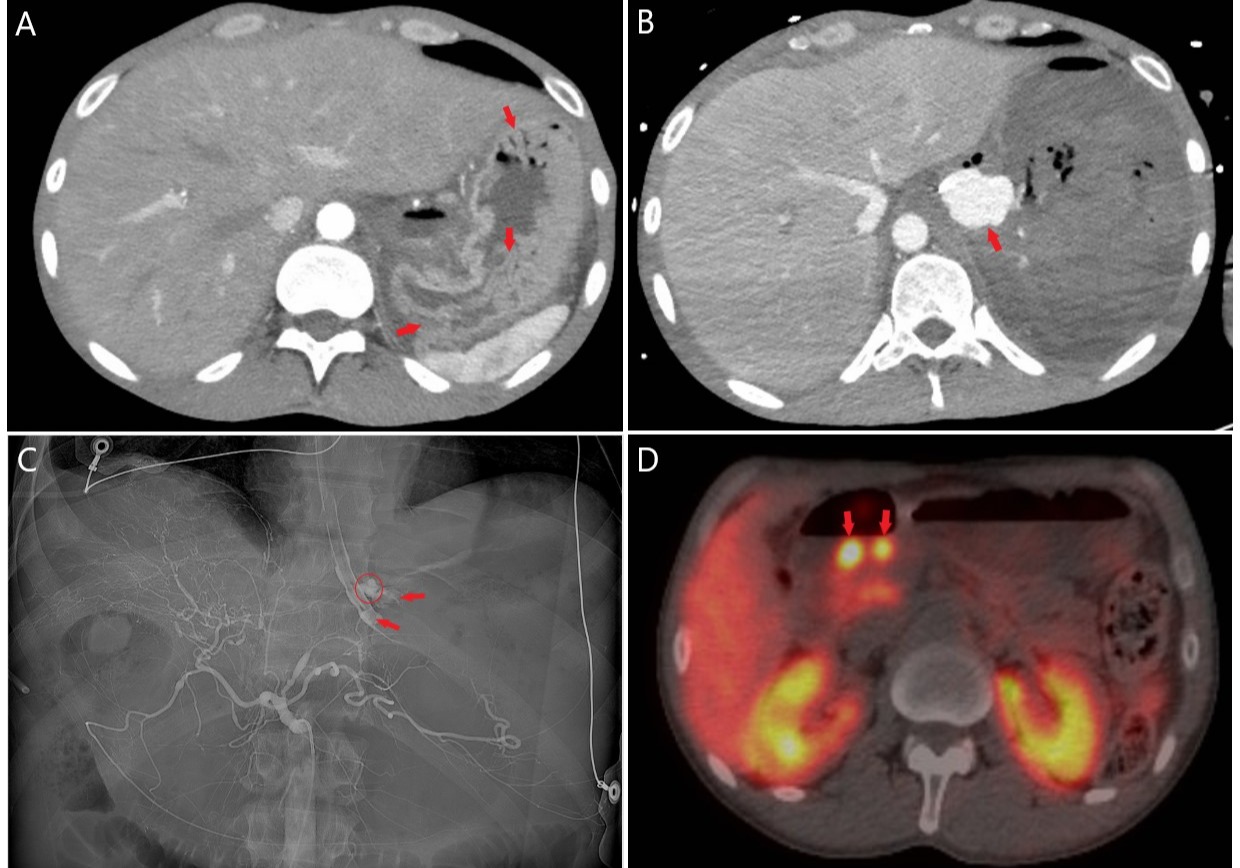Sunday Poster Session
Category: GI Bleeding
P0668 - Cardiac Arrest From a Gastrinoma-Related Distal Esophageal Pseudoaneurysm Hemorrhage
Sunday, October 22, 2023
3:30 PM - 7:00 PM PT
Location: Exhibit Hall

Has Audio
.jpg)
Mark Cromer, MD
University of Alabama at Birmingham
Birmingham, AL
Presenting Author(s)
Mark Cromer, MD, Frederick Weber, MD
University of Alabama at Birmingham, Birmingham, AL
Introduction: Zollinger-Ellison syndrome (ZES) is a rare condition caused by a gastrin-releasing neuroendocrine tumor (NET), a gastrinoma, that is characterized by hypergastrinemia, gastric acid hypersecretion, chronic diarrhea, and recurrent peptic ulcer disease (PUD). Severe complications of ZES are uncommon. Cardiac arrest from a gastrinoma-related bleeding ulcer with hemorrhagic shock has not been previously reported.
Case Description/Methods: A 47-year-old male with recurrent alcoholic pancreatitis and recently diagnosed PUD presented to the ED with epigastric abdominal pain, chronic diarrhea, and melena. He reported frequent NSAID use and PPI nonadherence since his PUD diagnosis. Abdominal CT scan noted prominent gastric folds but no active GI bleeding. Repeat EGD found LA grade D esophagitis, a large distal esophageal ulcer, and multiple duodenal ulcers without stigmata of recent bleeding. Esophageal biopsy showed fibrino-inflammatory exudate, necrotic stroma, and no neoplasia; gastric biopsy was negative for H. pylori. He was diagnosed with NSAID-related PUD and discharged home with high-dose PPI. Four days later he returned with hematemesis, severe anemia, and shock resulting in cardiac arrest but with successful resuscitation. Abdominal CT showed a large distal esophageal pseudoaneurysm with active intra-gastric hemorrhage. Angiography identified extravasation from left and right gastric artery branches which were successfully embolized. Review of prior admission CT showed two enhancing duodenal bulb lesions suspicious for a NET. Serum gastrin level resulted at >4,500 pg/mL. An EUS was unrevealing, but a Gallium-68 DOTATATE PET/CT revealed two areas of somatostatin enhancement posterior to the pylorus. He ultimately improved with 80mg PPI TID and was discharged with follow up for gastrinoma resection and genetics evaluation.
Discussion: The most common symptoms of ZES are abdominal pain, chronic diarrhea, and heartburn (up to 78%, 75%, and 42% of cases, respectively); chronic diarrhea may be the single presenting symptom in 3-10% of cases. PUD has been identified via EGD in 75% of cases. Severe complications of ZES, sequela of gastric acid hypersecretion and mucosal ulceration, are uncommon (e.g., bleeding 27%, pyloric / duodenal scarring 10%, esophageal stricture 4%). Pseudoaneurysm, hemorrhagic shock, and cardiac arrest have not been previously reported with ZES. The presence of chronic diarrhea and atypical PUD should raise suspicion for ZES, even in the setting of more common culprits of PUD.

Disclosures:
Mark Cromer, MD, Frederick Weber, MD. P0668 - Cardiac Arrest From a Gastrinoma-Related Distal Esophageal Pseudoaneurysm Hemorrhage, ACG 2023 Annual Scientific Meeting Abstracts. Vancouver, BC, Canada: American College of Gastroenterology.
University of Alabama at Birmingham, Birmingham, AL
Introduction: Zollinger-Ellison syndrome (ZES) is a rare condition caused by a gastrin-releasing neuroendocrine tumor (NET), a gastrinoma, that is characterized by hypergastrinemia, gastric acid hypersecretion, chronic diarrhea, and recurrent peptic ulcer disease (PUD). Severe complications of ZES are uncommon. Cardiac arrest from a gastrinoma-related bleeding ulcer with hemorrhagic shock has not been previously reported.
Case Description/Methods: A 47-year-old male with recurrent alcoholic pancreatitis and recently diagnosed PUD presented to the ED with epigastric abdominal pain, chronic diarrhea, and melena. He reported frequent NSAID use and PPI nonadherence since his PUD diagnosis. Abdominal CT scan noted prominent gastric folds but no active GI bleeding. Repeat EGD found LA grade D esophagitis, a large distal esophageal ulcer, and multiple duodenal ulcers without stigmata of recent bleeding. Esophageal biopsy showed fibrino-inflammatory exudate, necrotic stroma, and no neoplasia; gastric biopsy was negative for H. pylori. He was diagnosed with NSAID-related PUD and discharged home with high-dose PPI. Four days later he returned with hematemesis, severe anemia, and shock resulting in cardiac arrest but with successful resuscitation. Abdominal CT showed a large distal esophageal pseudoaneurysm with active intra-gastric hemorrhage. Angiography identified extravasation from left and right gastric artery branches which were successfully embolized. Review of prior admission CT showed two enhancing duodenal bulb lesions suspicious for a NET. Serum gastrin level resulted at >4,500 pg/mL. An EUS was unrevealing, but a Gallium-68 DOTATATE PET/CT revealed two areas of somatostatin enhancement posterior to the pylorus. He ultimately improved with 80mg PPI TID and was discharged with follow up for gastrinoma resection and genetics evaluation.
Discussion: The most common symptoms of ZES are abdominal pain, chronic diarrhea, and heartburn (up to 78%, 75%, and 42% of cases, respectively); chronic diarrhea may be the single presenting symptom in 3-10% of cases. PUD has been identified via EGD in 75% of cases. Severe complications of ZES, sequela of gastric acid hypersecretion and mucosal ulceration, are uncommon (e.g., bleeding 27%, pyloric / duodenal scarring 10%, esophageal stricture 4%). Pseudoaneurysm, hemorrhagic shock, and cardiac arrest have not been previously reported with ZES. The presence of chronic diarrhea and atypical PUD should raise suspicion for ZES, even in the setting of more common culprits of PUD.

Figure: Figure 1: Images of the case
A and B: Abdominal CT images highlighting prominently enlarged gastric folds (arrows) from hospital admission prior to the patient's cardiac arrest (A), and the distal esophageal pseudoaneurysm with active-intragastric hemorrhage (arrow) immediately following cardiac arrest (B). C: Angiography image capturing the distal esophageal pseudoaneurysm (circle) along with foci of active hemorrhage (arrows). D: PET CT DOTATATE image depicting two duodenal lesions with somatostatin enhancement consistent with gastrinomas.
A and B: Abdominal CT images highlighting prominently enlarged gastric folds (arrows) from hospital admission prior to the patient's cardiac arrest (A), and the distal esophageal pseudoaneurysm with active-intragastric hemorrhage (arrow) immediately following cardiac arrest (B). C: Angiography image capturing the distal esophageal pseudoaneurysm (circle) along with foci of active hemorrhage (arrows). D: PET CT DOTATATE image depicting two duodenal lesions with somatostatin enhancement consistent with gastrinomas.
Disclosures:
Mark Cromer indicated no relevant financial relationships.
Frederick Weber indicated no relevant financial relationships.
Mark Cromer, MD, Frederick Weber, MD. P0668 - Cardiac Arrest From a Gastrinoma-Related Distal Esophageal Pseudoaneurysm Hemorrhage, ACG 2023 Annual Scientific Meeting Abstracts. Vancouver, BC, Canada: American College of Gastroenterology.

